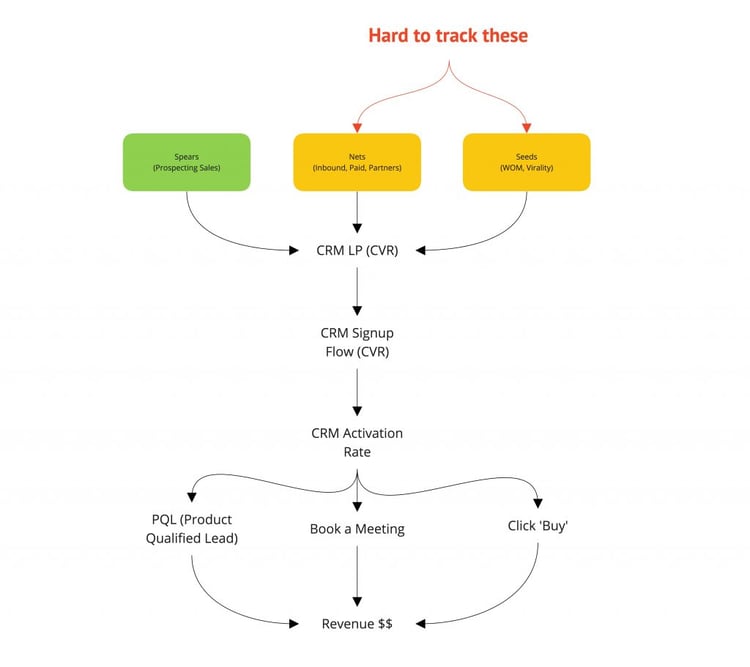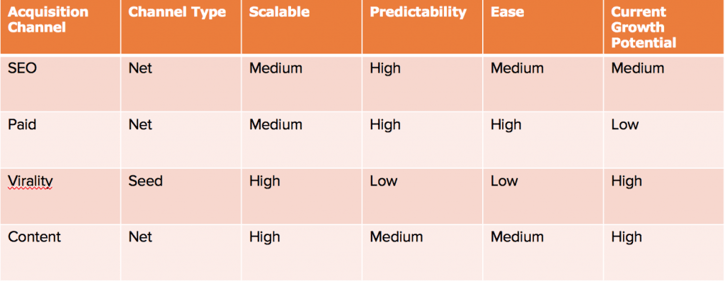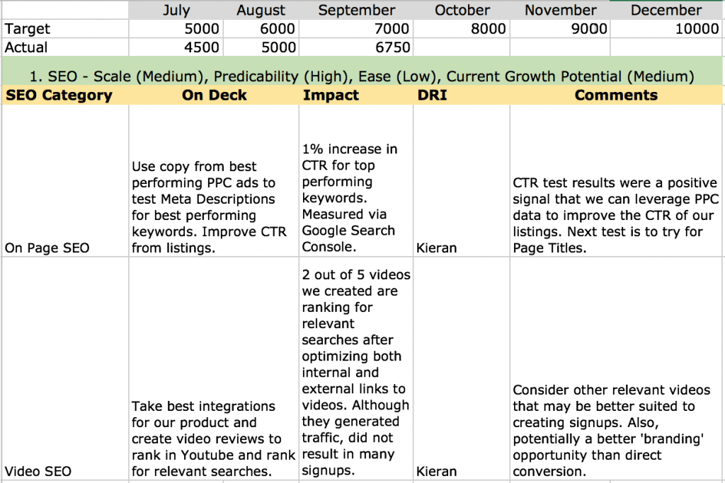In this episode of the GrowthTLDR, we talk about some of the latest tech stories, including Loom updating their pricing and Notion launching jobs to be done guides, and how you can build a customer acquisition model for 2021.
We get into creating targets via a bottom-up exercise, how you can decide what channels are worth the investment, and how to build a growth scorecard for each channel.
Happy Growing
All acquisition marketers love the rush of reading about a new tactic. In particular, if there is a meaty result included.
Although we did all those things at HubSpot whilst growing our freemium funnel to a multi-million dollar business, I would love to talk about the less adrenaline fueled side of acquisition ..... strategy!
We all know that trying to predict acquisition is the hardest part of most funnel models.
Let's assume you're in the first week of a new role heading up a growth team; the CEO gives you the revenue targets for the year and asks you to produce a model of the funnel that will show how you're going to hit those targets.
After spending roughly 30 mins freaking out, you begin going through the math. Here is a basic chart on how this might look for our free CRM product (the real funnel would look a lot more complex).

You'll start at revenue and work backward. You'll know:
- What % of my revenue do I expect to be from a touchless sale (click 'buy') and what % should come from human interaction.
- Once you know those, you'll be able to put goals around improving conversion rates on each interaction e.g. booking a meeting or taking an action that would qualify you as a product lead.
- You'll then set goals against how much better the conversion rates could be for your signup flow and signup page.
The result will be a target for both the traffic you need to generate to the signup page and the overall number of signups you need to create.
Of course, not every signup will need to come from a visit to your signup page e.g. integrations, we would take that into account when determining traffic goals.
The above is an oversimplified version of how the funnel may look for our free CRM product, you would build out a more detailed version of how it worked for your business.
The next part is to figure out how you can account for those metrics across your different acquisition channels. Modeling this against 'Spears' (Sales prospecting) isn't hard, but modeling out both 'Nets' (Inbound, PPC, Partners etc) and 'Seeds' (WOM, virality) is complex.
Where to bet your acquisition chips?
You now have your targets (traffic & signup) and find yourself at a poker table trying to figure out where to place your chips (budget & resources). The goal of this stage is to get more decisions right than wrong.
The only time it's ok to get more decisions wrong than right, is when a couple of the bets you make pay off in a big way.
Let's get gambling!
To help you figure out where you should stack your acquisition chips, I would recommend building out a channel map.

Measure each channel based on the parameters below to help you make better choices with your chips:
a. Scalable: - How scalable do you think the channel is? Is there a lot of search volume for keywords that are related to your product? Do your unit economics support investment in paid channels? Can you create a lot of content to attract people who are in the awareness stage of the buying cycle and convince them to try your product?
Making an educated guess on how scalable each channel is will help you understand are your teams prioritizing activity that will yield long-term growth.
b. Predictability: - How predictable is the channel. Your answers for this will depend on how active you currently are on that channel. For channels you're already heavily invested in, it's much easier to predict growth. For new channels you're targeting, it can be much more challenging.
If you need fast growth, investing in highly scalable channels that are difficult to predict could be the wrong option.
c. Ease: - How easy is it for you to attack that channel. For paid you may just need a bigger budget, or for content better writers, but for virality, you need proper loop mechanics and a product that's easy to adopt.
It can help you prioritize your time against channels where you can get some quick wins.
d. Current Growth Potential: - Are there many opportunities for growth left in a particular channel? For example, if you've invested heavily in SEO, maybe your rankings are verging on as good as it gets.
Investing in that channel will only get you nominal gains. That time could be better spent in a channel that has a lot more growth potential that you haven't yet tapped into.
Having a channel map helps you to prioritize your attack plan against parameters that make the most sense for you.
Usually, you want to distribute your teams time against channels that have good predictability, are easy to get some wins and still have some growth potential, but also ensure you're investing some time against channels that are highly scalable but could be less predictable.
Your Growth Scorecards
Once you've decided on what channels you're going to prioritize, it's time to get cranking! However, acquisition can be a tricky beast to track.
I've always found tracking everything after signup/lead much easier to put tangible goals against. We add all experiments to a master doc along with an accompanying Trello board. It's easy to track what tests are active and what impact they've had in any given month.
It can be more challenging to measure acquisition in the same way. Measuring the performance of your acquisition channels often involves tracking many different tasks across different mediums. Often measuring the impact on these tasks can be difficult.
Creating monthly growth scorecards can help. For example, you've decided there is still some growth potential in SEO and it wouldn't be too difficult to extract more signups from that channel:

Your scorecard for the current month (in the above case it would be September) can show how you're trending against your target and what tactics you implemented in September.
It can give a quick summary of the impact of each play along with comments from the channel DRI on the activity they executed that month.
Each month the DRI for each channel will send you the growth scorecard including their tasks for the current month along with progress made against targets.
But where do the channel targets come from?
The targets for each channel are based on both the signup and visit target you figured out in the funnel model above. It's easy to predict a channel like paid, much more difficult to do so with things like SEO, virality, and many others.
Your accuracy is also better for channels that you're already invested in as you'll have historical trends to plot against.
Let's assume you had to generate 1000 signups per month, which is 10,000 visits to your signup page. You've decided to invest in both SEO and paid to hit this target but also start investing in virality as you see the growth potential slowing in SEO.
You can then split the number of signups that need to come from each channel. Given virality could be a new channel you're investing in, I wouldn't give it a specific target until you have some initial base data to work out a model. This is one of my favorite posts on virality, it comes with a template to forecast growth. Instead, I would set a delivery date on when you feel you'll have enough experiments run and data collected to know how predictable that channel could be.
You now simply need to model out targets across both paid and SEO that will get you to your number. If you know these channels combined won't be enough to hit your target, I would add in a bucket for 'Other' and how many signups you need to generate from that. You would then include the channels your testing in order of priority to find 1 or 2 that will make up the number of signups that need to come from 'Other'.
The above may seem pretty simple, but a lot of companies waste countless amount of energy and time on trying to create overly complex models for acquisition. Outside of paid marketing, the results from most acquisition channels have a huge amount of variance within them. The steps detailed in this post will help you to create an acquisition strategy focused on the correct areas for growth.
I hope this was helpful. It may not be as sexy as "how I doubled my email open rates with the power of positive thinking" :), but an effective acquisition strategy can be the difference between success and failure.
If you enjoyed this article signup for my newsletter below where I share the top 3 articles I've come across on growth over the past month along with my tl;dr comments on the most important points from each one. That's right, only one email per month.
 iTunes
iTunes Stitcher
Stitcher Spotify
Spotify